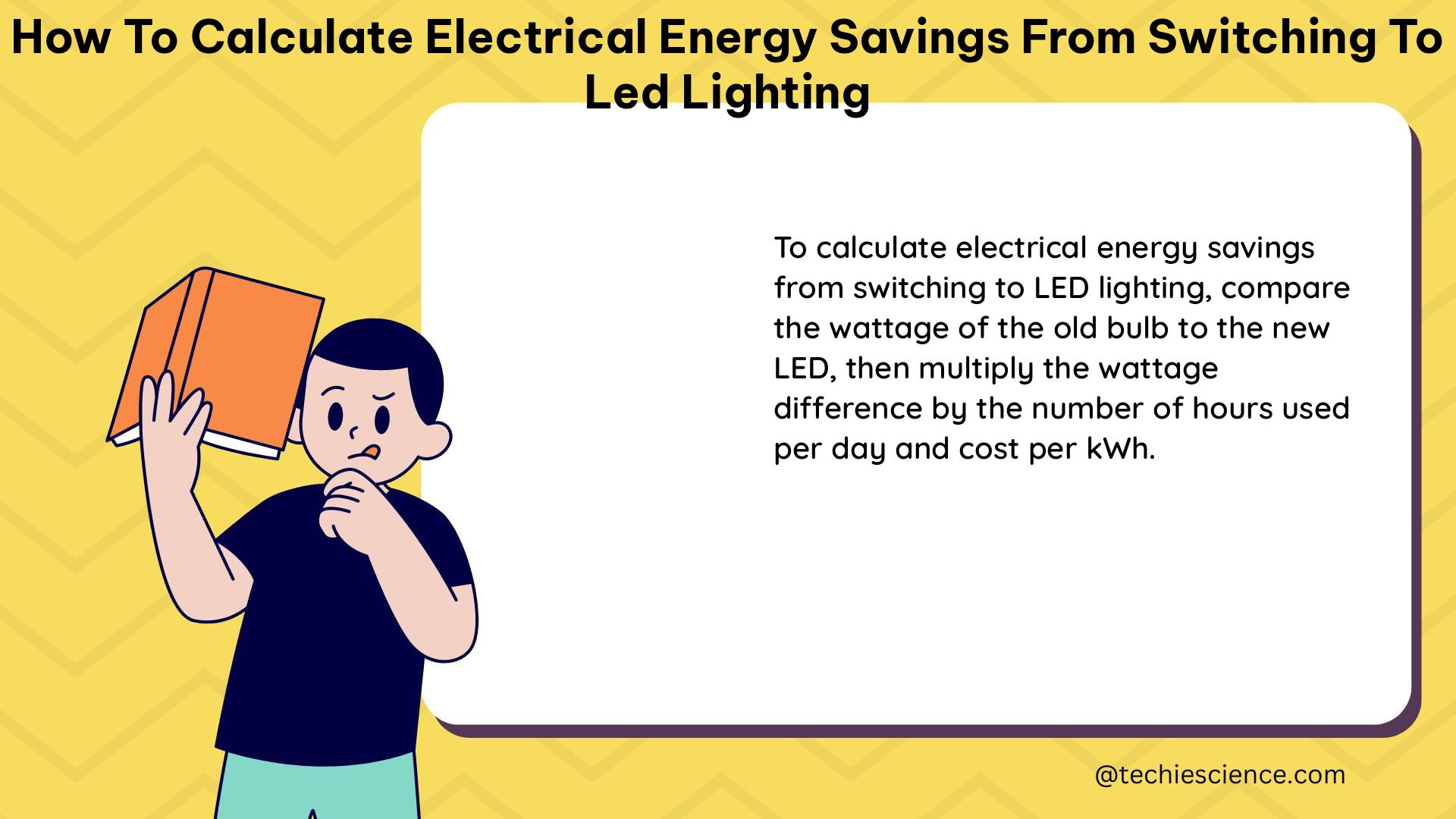Switching from traditional incandescent or fluorescent lighting to energy-efficient LED (Light-Emitting Diode) lighting can significantly reduce your electricity consumption and lower your energy bills. To accurately calculate the electrical energy savings from this transition, you’ll need to consider several key factors. This comprehensive guide will walk you through the step-by-step process of determining the potential energy and cost savings when switching to LED lighting.
Determine the Wattage and Usage of Existing Bulbs
The first step in calculating the energy savings is to gather information about your current lighting setup. For each type of bulb you have, note the following:
- Wattage: Determine the wattage of the existing bulbs. This information is typically printed on the bulb or can be found in the product specifications.
- Daily Usage: Estimate the number of hours per day that the bulbs are in use. This can vary depending on the location and purpose of the lighting.
For example, let’s say you have 10 incandescent bulbs, each rated at 60 watts, that are used for 3 hours per day.
Select Appropriate LED Replacements

Next, you’ll need to find the LED bulbs that will replace your existing bulbs. When selecting the LED replacements, consider the following:
- Wattage: Determine the wattage of the LED bulbs that will provide the same or similar light output as the existing bulbs. LED bulbs are generally much more energy-efficient, so the wattage will be significantly lower.
- Daily Usage: Assume the same daily usage hours as the existing bulbs, unless you plan to change the lighting schedule.
Continuing the example, you might replace the 60-watt incandescent bulbs with 9-watt LED bulbs, while maintaining the 3-hour daily usage.
Calculate Energy Use for Existing and LED Bulbs
To calculate the energy use for both the existing and LED bulbs, you’ll need to use the following formula:
Energy Use (kWh) = Wattage × Daily Usage (hours) / 1000
Where:
– Wattage is the power rating of the bulb in watts
– Daily Usage is the number of hours the bulb is used per day
– 1 kWh (kilowatt-hour) = 1000 watt-hours
Applying this formula to the example:
Existing Incandescent Bulbs:
– Energy Use = 60 watts × 3 hours / 1000 = 0.18 kWh per day
LED Replacement Bulbs:
– Energy Use = 9 watts × 3 hours / 1000 = 0.027 kWh per day
Calculate Daily Energy Savings
To determine the daily energy savings, subtract the energy use of the LED bulbs from the energy use of the existing bulbs:
Daily Energy Savings = Energy Use of Existing Bulbs – Energy Use of LED Bulbs
Daily Energy Savings = 0.18 kWh – 0.027 kWh = 0.153 kWh
Calculate Annual Energy Savings
To calculate the annual energy savings, multiply the daily energy savings by the number of days in a year (365):
Annual Energy Savings = Daily Energy Savings × 365 days
Annual Energy Savings = 0.153 kWh × 365 days = 55.845 kWh
Calculate Cost Savings
To determine the cost savings, multiply the annual energy savings by the cost of electricity per kilowatt-hour (kWh). The cost of electricity can vary depending on your location and utility provider.
Cost Savings = Annual Energy Savings × Cost of Electricity per kWh
Cost Savings = 55.845 kWh × $0.12 per kWh = $6.70
Consider Additional Factors
While the above calculations provide a good estimate of the energy and cost savings, there are a few additional factors to consider:
- LED Bulb Efficiency: The energy efficiency of LED bulbs can vary, so it’s important to choose high-quality LED replacements that offer the best energy savings.
- Installation Costs: The initial cost of purchasing and installing the LED bulbs should be factored into the overall savings calculation.
- Maintenance Savings: LED bulbs typically have a much longer lifespan than traditional bulbs, which can result in reduced maintenance and replacement costs over time.
- Environmental Impact: LED bulbs use significantly less energy and have a lower carbon footprint compared to incandescent or fluorescent bulbs, contributing to a more sustainable future.
By considering these additional factors, you can get a more comprehensive understanding of the overall benefits of switching to LED lighting.
Utilize Energy Savings Calculators
To simplify the calculation process and get a more accurate estimate, you can use online energy savings calculators. These tools often take into account a wider range of variables, such as utility rates, bulb lifespan, and installation costs, to provide a more detailed analysis of the potential savings.
Some popular energy savings calculators include:
– Bulbs.com Energy Savings Calculator
– LED Savings Calculator from The Calculator Site
Conclusion
Calculating the electrical energy savings from switching to LED lighting involves a step-by-step process that considers the wattage and usage of existing bulbs, the selection of appropriate LED replacements, and the calculation of energy use, daily savings, annual savings, and cost savings. By taking into account additional factors and utilizing energy savings calculators, you can obtain a more comprehensive understanding of the benefits of transitioning to energy-efficient LED lighting.
References:
– Bulbs.com Energy Savings Calculator – https://www.bulbs.com/learning/energycalc.aspx
– LED Savings Calculator – https://www.thecalculatorsite.com/energy/led-savings-calculator.php
– U.S. Department of Energy – https://www.energy.gov/energysaver/save-electricity-and-fuel/lighting-choices-save-you-money/led-lighting

The lambdageeks.com Core SME Team is a group of experienced subject matter experts from diverse scientific and technical fields including Physics, Chemistry, Technology,Electronics & Electrical Engineering, Automotive, Mechanical Engineering. Our team collaborates to create high-quality, well-researched articles on a wide range of science and technology topics for the lambdageeks.com website.
All Our Senior SME are having more than 7 Years of experience in the respective fields . They are either Working Industry Professionals or assocaited With different Universities. Refer Our Authors Page to get to know About our Core SMEs.